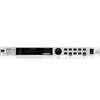Behringer FEEDBACK DESTROYER PRO DSP1124P Manual - Page 14
Operating Modes Of The Dsp1124p - feedback destroyer pro manual
 |
View all Behringer FEEDBACK DESTROYER PRO DSP1124P manuals
Add to My Manuals
Save this manual to your list of manuals |
Page 14 highlights
FEEDBACK DESTROYER PRO DSP1124P 6. OPERATING MODES OF THE DSP1124P The individual filters on the BEHRINGER FEEDBACK DESTROYER PRO can operate in four different modes (see ). An additional mode called “Locked” mode will be described specifically. Basically, each of the 2 x 12 filters on the DSP1124P can be set to any of the four operating modes. To meet more complex requirements with regard to flexible signal processing, these modes can be combined in a program and stored in a preset. 6.1 Off mode “OF” In Off mode, the corresponding filter is deactivated and can be activated by selecting one of the modes described below. 6.2 Manual filters (“PA”) / parametric equalizer To raise or lower specific frequencies in level, you can select these frequencies directly by setting the manual filters to Parametric EQ mode. Each filter has the functionality of a fully parametric EQ, i.e. you can set the center frequency (FREQUENCY key ), the bandwidth (BANDWIDTH key ) and the amount of boost/cut (in dB) using the GAIN key . 6.3 Automatic filters (“SI” and “AU”) Automatic filters operate in two modes: Single-Shot (SI) and Auto mode (AU). In order to find a feedback frequency, the FEEDBACK DESTROYER PRO divides the entire frequency band into 1/60 octave steps (20 Hz to 20 kHz) and determines the respective level of these individual bands. The unit then compares this value to the level of the entire signal. The difference between these levels determines whether a filter is set or not. The FEEDBACK DESTROYER PRO gives you the unique possibility of adapting this parameter according to your own needs. You can edit the feedback sensitivity (i.e. the difference value) within a range from -3 to -9 dB, in 1-dB steps: Simultaneously press the FILTER MODE and GAIN keys, then use the JOG WHEEL to select a value. The standard value for this parameter is -6 dB, which provides for an optimum detection of feedback in most applications. Example: During a pure speech transmission, the feedback sensitivity can be lowered to -9 dB. In this way, the algorithm would recognize and suppress feedback even faster. On the other hand, a higher setting, e.g. -3 dB, allows you to leave those signals unaffected which you don’t want to suppress (e.g. guitar or keyboard signals). Filters in Single-Shot mode automatically analyze the music signal to detect feedback frequencies. Having detected such a frequency, the filter automatically configures its parameters to suppress feedback as efficiently as possible. As the filter is locked to the detected frequency, this mode is ideally suited to suppress feedback of constant frequency. Possible applications are “fixed-position” microphones (e.g. on the drums). After the filter has adjusted itself automatically, it enters a special Locked mode (see chapter 6.4), which means that although the frequency remains fixed, the width and depth of the filter are still being adapted to the feedback frequency, i.e. the width is increased as soon as the feedback frequency begins to shift, and the gain is cut if feedback prevails. The gain is not reduced to prevent feedback from recurring. All microphones that are moved during a performance (e.g. vocal mics) very often have varying feedback frequencies. This type of feedback should be suppressed in Auto mode. As in Single-Shot mode, the filter automatically selects an ideal setting for feedback suppression. However, in Auto mode the first AU filter set is unlocked to suppress new feedback. The optimum frequency is selected automatically and the filter is set to narrow-band mode, so as to influence the music signal as little as possible. If your music contains wanted feedback elements (e.g. guitar feedback), it is highly probable that these will be suppressed too in Auto mode, because it is impossible from a physical point of view to distinguish “wanted” from “unwanted” feedback. Please read chapter 2.3 to find some information on how to work around this situation. 14 6. OPERATING MODES OF THE DSP1124P















